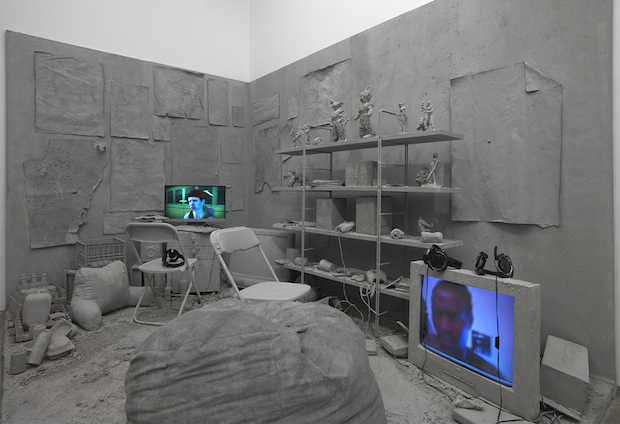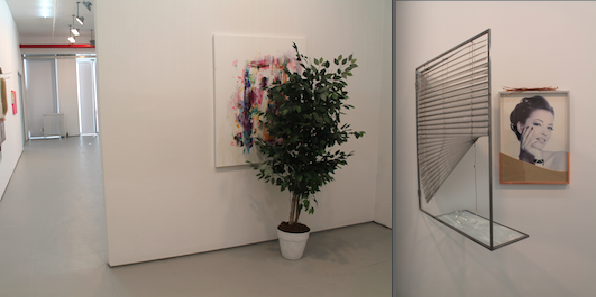Post Culture
Elizabeth Dee (545 West 20th Street)
Through October 26th
What’s on view: A group show of abstract paintings incorporating commercial and domestic objects, screenprints, and videos; according to the press release, related to “abundant image dissemination”
Corinna: The first thing I noticed about this show: it looks trendy. I was instantly reminded of art fairs from like, the last two or three years. There’s abstract paintings that aren’t necessarily painted all that well—like Julia Wachtel’s Doughnutville (1992), consisting of two flatly painted garish pink-and-orange panels that squeezed in a rasterized image of a guy in a suit and tie, maybe from the 1980s. It was an ugly painting. Gabriele Beveridge’s painting Post-Exertion Visibility (2013) included a blonde-haired ponytail—to which my friend replied that one of our mutual friends, an artist out in Bushwick, had recently started using wigs in his work, too. Then there was Torben Ribe’s Walgreen’s aesthetic; If You Are What You Do, Who Are You When You Lose Your Job (2010-12), there were those single packs of spa mud masks tacked onto the canvas.
Oh, and to top it off, there had to be a potted plant in the gallery. Why, of course.
Whitney: Agreed, it’s in line with the intellectual antiseptic Mousse Magazine-Independent Fair look which immediately makes me disengage.
I do think this is the kind of show where if you give it time, something could start to happen. Gabriele Beveridge’s aging fashion portraits with broken glass, Venetian blinds, sand, and old pegboard seem like they could be deeper moments about fleetingness of image culture in another show. This especially next to Julia Wachtel’s Doughnutville, since it looks very similar but was made over twenty years ago. As for ugly, I’d nominate Torbin Ribe’s If You Are What You Do, Who Are You When You Lose Your Job? , made from face mask cream. It’s pasty in every sense and at least sort of farts at minimalist corporate perfectionism.
But there was too much sameness of style, which undercuts the better moments. TVs and surveillance stills hint at an engagement with the world, but the trendy minimalism dominates the content as an organizing theme. This show can write a thesis, but I won’t take it beyond the gallery.
Matthew Day Jackson: Something Ancient, Something New, Something Stolen, Something Blue
Hauser & Wirth (511 West 18th Street)
Through October 19th
What’s on view: Large, very large bronze sculptures, some skeletons, burnt wood paintings, and a classic, custom-built car.
Corinna: Did you read this scathing review of the Matthew Day Jackson show in The New Yorker? I was kinda shocked. I know that taste is taste, but I liked this show alright.
Whitney: This didn’t exactly inspire that kind of hatred for me, but yeah, I thought it was okay. Jackson’s trying to take on time and death with his moonrock Pieta, galvanized map of Paris, and horror room of skeletons in mirrored boxes—the themes outsize even Hauser & Wirth’s massive space. I did like that house of horrors room; there’s something schlocky about rubber Halloween skins hanged by metal rods, in mirrored booths, and it injects some humanity into what’s otherwise a very blue chip show.
The most surreal moment for me: coming around one of those enormous hallways and stumbling upon Matthew Day Jackson mid-lecture. The space is huge, so people were clustered in pairs and spaced several feet apart, listening to Jackson tell them about time, space, and eternity. It was like watching a colonial village gathering around the oracle. Very weird.

Jon Rafman, I am Alone but Not Lonely, 2013 Mixed Media Installation including video, various objects, trash and volcanic ash (chinchilla dust) (Image courtesy of Zach Feuer)
Jon Rafman: You are Standing in an Open Field
Zach Feuer (548 West 22nd Street)
Through October 26th
What’s on view: Dakimakura (anime sex pillows), an art studio covered in volcanic ash, molten anime armor and laptops playing videos
Corinna: I really wanted to love this show. I like Jon Rafman, and this is his first solo show with Zach Feuer. But overall, this wasn’t his best work. In particular, his objects didn’t seem to translate into the Feuer space.
Rafman’s work is often melancholy, and digs deep into how we create the world we see around us. In that way, his videos often feel like explorations, and his objects feel like relics. But there was something off about the objects; they mostly seemed shoddy.
Still, his videos are great, if you get a chance to see them. This line from the solitary narrator in A Man Digging, wandering through the sparsely populated scenes in the video game Max Payne 3, sums up our contemporary plight pretty nicely:
One afternoon, I traveled back to the edge of my memory. Images of the past, layered with nostalgia obstructed my enjoyment of present beauty.
I had to go back and watch the video online, but lines like this make me really like Rafman; he doesn’t buy into nostalgia. Also, the vids are gorgeous to watch—the empty, sprawling vistas are really awe-inspiring, and sublime.
So anyway, in sum: videos, good; objects, meh. Oh, and it’s all new-ish work. So don’t expect to see any Nine Eyes.
Whitney: I saw the show before the videos went up, and saw the videos online after. Initially, the objects (sex pillows, a ton of anime/gaming paraphernalia on racks and the wall) made me worried. It looked like Rafman was banking on Internet voyeurism into a very real culture and people’s fetishes.
I’m willing to forgive a lot of that for the videos. I thought of A Man Digging as like a hangover from a virtual rampage: the camera floats through landscapes full of bloody corpses in alleys, docks, nightclubs. He talks about getting to “the far edge of the real” over hyperreal trains which are slowly getting chipped away. (Now the encrusted laptops and Matthew Day Jackson-style video game armor make more sense). And agreed about the beauty of the tableaus—the use of lighting and air are really stunning, and help to illustrate a certain kind of emotional wasteland that comes from spending a lot of time in the game.





Comments on this entry are closed.